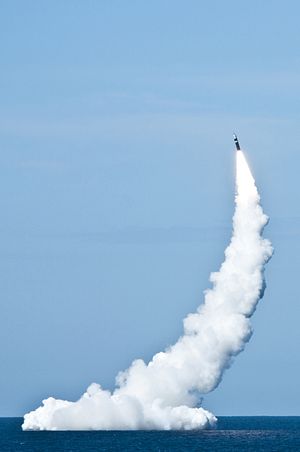Last week, Franz-Stefan Gady provided a helpful round-up of the confusing evidence surrounding the existence of Pakistan’s sea-based second nuclear strike capability. Since 2012, when Pakistan created its Naval Strategic Force Command, there has been considerable concern, in India and elsewhere, that Pakistan is close to imminently operationalizing a sea-based second strike capability. Though analysts remain divided over the question of how far Pakistan has taken its sea-based deterrent (we know, for example, that Pakistan has neither the quantity nor quality of submarines to effectively implement this yet), it’s worth understanding the consequences of such a development on strategic stability in South Asia.
First, what we know now suggests that any Pakistani sea-based second strike capability will depend on a sea-launched variant of the Hatf-VII Babur cruise missile. The Hatf-VII, a medium-range subsonic cruise missile, tops out at a range of 700 km, meaning that a submarine-based launch system would need to operate in waters relatively close to the prospective enemy’s shores (in Pakistan’s case, India). This brings up a problem for Pakistan’s plans for a sea-based deterrent that more established nuclear powers with sea-based deterrents such as the United States, Russia, and the United Kingdom haven’t faced. The credibility of a second strike capability lies in the difficult of detecting submarines carrying submarine-launch ballistic missiles. Undersea radars and other anti-submarine warfare techniques, already a major point of interest for the Indian armed forces, could undermine Pakistan’s sea-based deterrent.
Interestingly, this observation means that the actual specifications of the submarine being engineered for Pakistan’s sea-based deterrent, with the help of China, is less interesting than the actual delivery vehicle. Even if Pakistan manages to operate submarines on par with China’s Type 032 Qing-class or Type 041 Yuan-class, capable of launching longer-range land attack cruise missiles (a max range of 1,500 km), these missiles are only capable of being armed with “unitary tactical nuclear warheads,” according to globalsecurity.org — a far cry from the strategic nuclear deterrent necessary to credibly field a second strike capability. Experts note that Pakistan will need a submarine fleet comprising 14 vessels in order to keep one nuclear-armed sub on stand-by at all times. Back under Pervez Musharraf’s leadership, Pakistan planned to expand its fleet to 12 vessels.
Additionally, as Bruno Tertias noted in a thoughtful post over at the Lowy Interpreter last year, even if we generously acknowledge a credible strategic sea-based second strike capability to Pakistan, there is no reason to believe that conventional strategic stability logic would apply; i.e., sea-based second strike capabilities existing on both sides of the India-Pakistan nuclear balance would lead to better long-term stability.
Also worth noting is that currently, nuclear escalation in South Asia is not an entirely frictionless process given India’s mostly credible No First-Use doctrine and Pakistan’s claim that it keeps its warheads separated from its launchers (even though it maintains a First-Use policy for deterrent purposes). For a conflict across the Radcliffe Line to escalate into a full-blown strategic nuclear exchange, Pakistan’s National Command Authority (NCA) would have to explicitly authorize nuclear use. A Pakistani sea-based deterrent would make this traditional decoupling of warheads from launchers less viable and, as a result, make nuclear first-use by Pakistan more likely. Not only will this possibility cause Indian strategic planners to lose sleep, but it would draw considerable concern from the United States and other nuclear powers.
The above reasons, in addition to the purely financial constraints Franz outlined in his piece, suggest that a sea-based second strike option for Pakistan is both a costly acquisition and one without a guarantee of giving Islamabad the upper-hand in the South Asian nuclear arms race. With India’s K-15 Sagarika, K-4, and Agni-VI SLBMs on the horizon of entering service, Islamabad will do everything it can to keep up. Additionally, a second-strike capability is important given Pakistan’s lack of strategic depth and the possibility of India modifying its NFU doctrine in the future (though I question the utility of India abandoning NFU altogether).

































